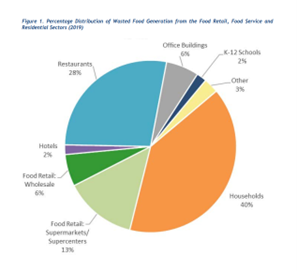Restaurants feed hungry people, but they also generate food waste. Whether you’re a single location with Michelin stars under your belt or a multi-state franchise, the problem remains the same: food waste, ending up in the trash. If you’re interested in exploring how you can be more sustainable not only in the food you bring in but the food waste you ship out, this blog is for you. We’ll go over the numbers from the EPA on food waste, how a service like Agri-Cycle can help, and what you’ll need to do.
How Much Food Waste Do Restaurants Generate?
The EPA estimates that in 2019, 66 million tons of wasted food was generated in the food retail, food service, and residential sectors, of which restaurants make up about 28%. This means restaurants generated about 18.5 million tons of food waste, over 60% of which was sent to landfills. An additional 40 million tons of wasted food were generated in the food and beverage manufacturing and processing sectors. This isn’t touching on the FOGS (Fat, Oils, Grease, and Solids) that are flushed down the drain and collected in grease traps—more on them in a minute.
 Food waste data from the EPA’s 2019 Wasted Food Report.
Food waste data from the EPA’s 2019 Wasted Food Report.
Want to learn more? Check out our blog, How Much Does Food Waste Cost the US?
Dealing with Food Waste from Restaurants Sustainably
So, can you recycle food waste from restaurants? You absolutely can. When it comes to solid food waste, there are two ways you can keep it out of the trash.
- Tote Bins for Your Commercial Kitchen: By placing our tote bins in your commercial kitchen at key points (and training staff on best practices), it’s easy to separate out food waste—and even filled food containers—from the rest of your waste.
- Food Waste Bins for Customers: The second major source of food waste is discarded food from customers when they are done with their meal. How this is dealt with depends on your service: self-service will need both designated food waste bins and clear signage.
Can Food Grease Be Recycled?
In most states, restaurants are also required to have a food grease trap—a device that filters out FOGS (Fat, Oils, Grease, and Solids) which are washed down the drains in your kitchens and other food prep areas. These grease traps are either serviced by staff or a pumping service that empties the traps (and usually also takes waste vegetable oil—WVO), but what do they do with them? Recently we acquired Food Grease Trappers, which believes in the same sustainable business practices as ourselves. Their food grease is used to feed anaerobic bacteria at our facilities and other sustainable initiatives. A great addition for our MA-based business partners.
Whether you’re looking for sustainable food waste practices to implement as part of a company-wide initiative or a state food ban, Agri-Cycle can help. For years we’ve been using our fleet of trucks and AD facilities to help business partners (including food processors, cafeterias, restaurants, grocers, residences, and more) better handle food waste while also saving money and improving their sustainability. Contact us today to learn more.

